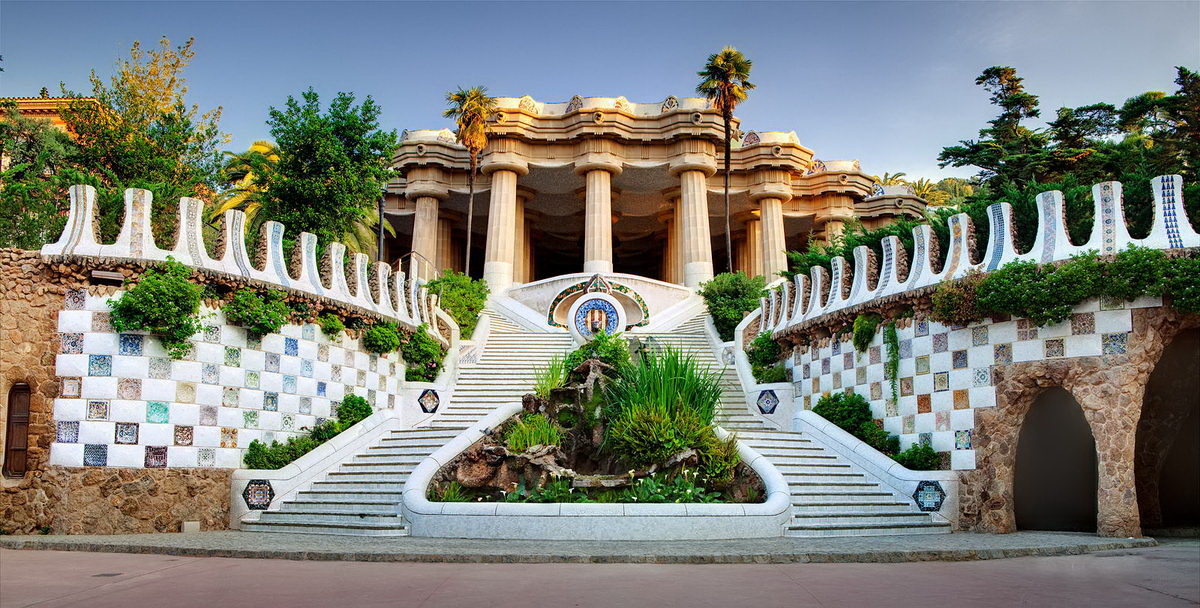History of Park Guell | Housing Development to Municipal Garden
Barcelona is a city suited to all kinds of tourists, whether you are a history buff, a food aficionado, or a beach bum. There is a lot to do in Barcelona and exploring the many gorgeous buildings in the city, and especially the ones crafted by Gaudi is definitely one of them.
Park Guell is one of Barcelona’s most-visited attractions, featuring some unique creations of Gaudi and lush gardens. This page delves into the history of this celebrated landmark.
What is Park Guell?
Located on Carmel Hill in Barcelona’s Gracia district, Park Guell is one of the most popular attractions in Barcelona. Originally conceived as a private residential area for affluent Catalan families, Park Güell is the work of world-renowned architect Antoni Gaudí who let his imagination go wild on the gardens and architectural elements of this park. His use of natural forms shaped into covered walkways, galleries, and archways beautifully camouflage the artificial structures into the surrounding Mediterranean hillside. A designated UNESCO World Heritage Site, Park Güell is now one of the most enchanting gardens of the world and captivates thousands of tourists every day.
Know More About Park Guell
Origins of Park Guell
In the 1900s Barcelona’s upper class began growing exponentially, while the rest of Spain was struggling economically. The economic crisis created room for the growth of Catalan nationalism, which was focused on the revival of Catalan traditions and national culture. Catalan artists and architects, thus, began being favored. It is this sentiment that allowed for Modernisme to develop in Catalan.
Buildings in this new modernist style came to be seen as not only a sign of patriotism but also of prestige. Aristocrats began to patron artistes of the Modernisme. Eusebi Guell’s and Antoni Gaudi’s relationship began when Güell saw a window display that Gaudí had planned for glove retailer at the Universal Exhibition in Paris in 1878. That same year, Güell commissioned him to make the furniture for the pantheon chapel at the Palacio de Sobrellano in Comillas.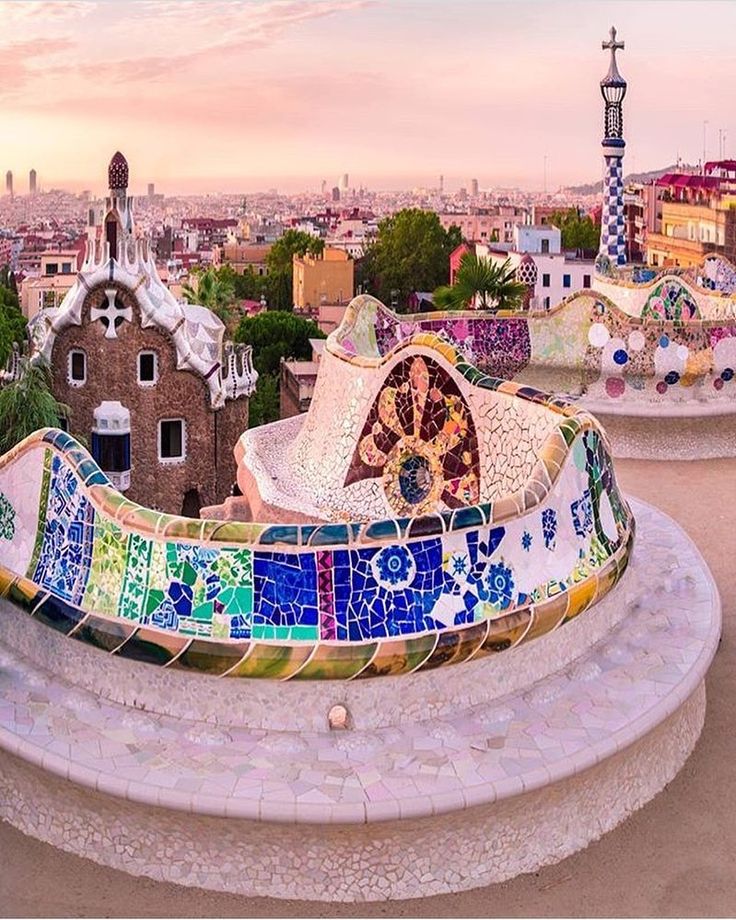
Architects of Modernisme
Lluis Domènech i Montaner
His works, Hospital de Sant Pau and Palau de la Música Catalana were collectively declared as a UNESCO World Heritage Site.
Josep Puig i Cadafalch
One of his most well-known buildings is his rebuilding of the Casa Amatller in Passeig de Gràcia.
History of Park Guell
Origin of Park Guell
In 1883, Joan Martorell, a professor of Gaudí, introduced him to Eusebi Güell, who ended up being his patron. Guell wished to build a housing project for aristocrats of Barcelona on a large estate called Bare Mountain. He was inspired by the British residential parks, which is what inspired the property its name, “Park Guel”.
The estate was located on a rocky hill with little vegetation and few trees. A large country house called Larrard House already existed on the site.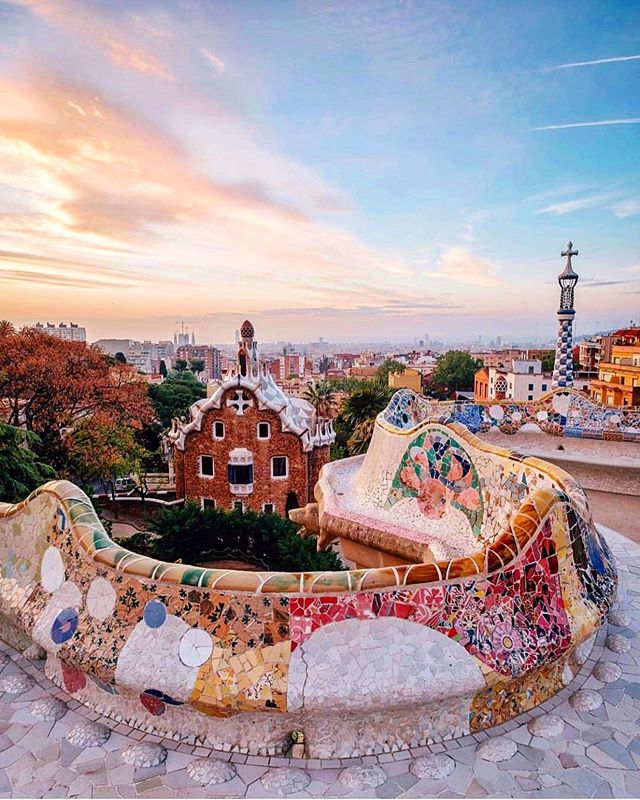
The plan for the development included 60 triangular plots that would be used for luxury houses, with a network of roads, viaducts, and stairs that did not compromise the topography of the land. It was also important that the houses would not disrupt the view of the sea or the flow of sunlight into the homes. These conditions were quite restrictive. However, they ensured that not only the existing vegetation was protected, but also introduced new species.
Gaudi and Guell
Construction of Park Güell
The construction of Park Guell began in October 1900 with the leveling of the land. By 1903, the two pavilions at the entrance, the main staircase, the waiting area, the exterior fence, viaducts, and part of the esplanade, as well as the drainage system, were completed.
In 1902, Martí Trias i Domènech bought the first plot of land in the park. He commissioned the architect Juli Batllevell to build his villa. Around the same time, Josep Pardo i Casanovas built a show house in the hopes that it would boost sales.
In 1906, Gaudí, at Güell’s suggestion, moved into the park. He lived here, with his family and father, until his death in 1926. Interestingly, the house he lived in was not built by him, but by Francesc Berenguer. The following year, Guell himself moved to the development, into the Casa Larrard. By this time, Hypostyle Hall was completely covered and events began being held in the main square. The tiled bench that surrounds it was completed in 1914.
Park Guell Facts
Housing Development to Public Park
The housing project failed for many reasons. The plots were to be sold using old emphyteutic contracts. The rather exclusive nature of the project as well the lack of adequate transport to the site, also made the project undesirable for prospective buyers. The project was abandoned in 1914 and by this point, only two of the 60 planned houses had been built.
It went from being a housing project to being a private garden.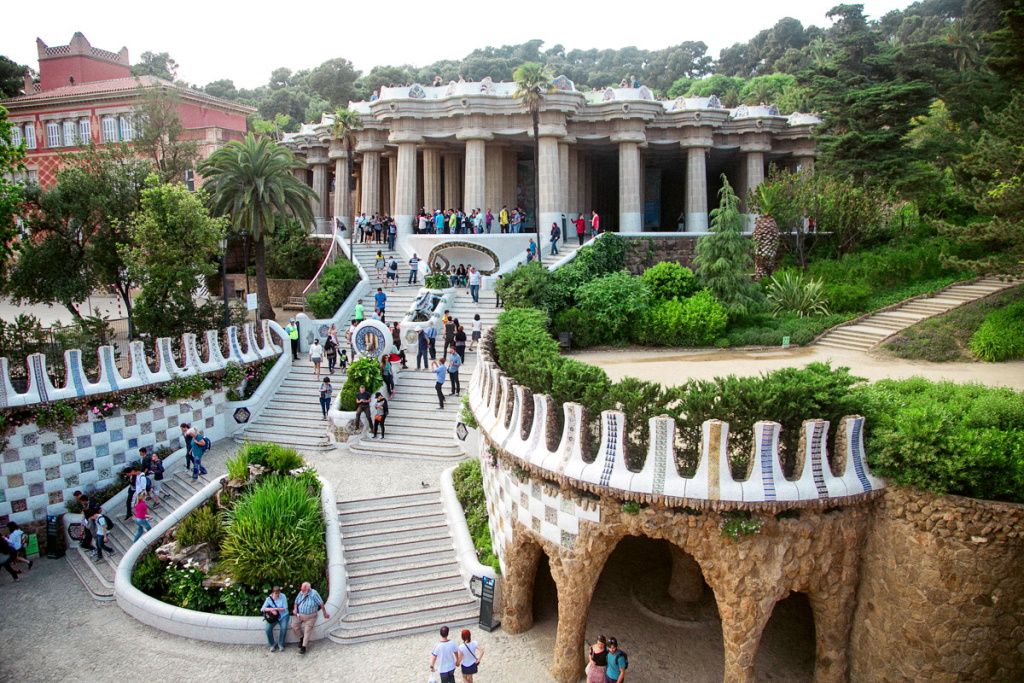
It was recognized as an artistic monument in 1969. The glory of the park finally culminated in 1984 when it was declared a World Heritage Site by UNESCO in 1984.
All Your Questions About Park Guell in Barcelona Answered
Q. When was Park Guell built?
A. Park Guell was built between 1900-1914.
Q. Who built Park Guell?
A. Park Guell was designed by Antoni Gaudi, who had been commissioned by Eusebi Güell.
Q. Where is Park Guell located?
A. Park Guell is located on Carmel Hill in Catalonia. Its address is 08024 Barcelona, Spain.
Q. Are Park Guell tickets available online?
A.
Q. What is Park Guell famous for?
A. Park Güell is a huge public park that features beautiful architectural elements designed by Antoni Gaudí. These architectural elements blend seamlessly with nature, making it a great place for relaxation just as much as it is a place to explore.
Q. Who lived in Park Guell?
A. In 1906, Gaudi moved to Park Guell with his samily and the following year, Guell moved into the Larrard House in the park. Both men lived here until their deaths in 1926 and 1918, respectively.
Q. Why was the housing development called Park Guell?
A. The project had been inspired by the British residential parks. Park Guell is a reference to this inspiration, as well as to Guell, the vision behind Park Guell.
Q. Why did the Park Guell housing project not pan out?
A. The housing project was abandoned as there were no buyers because of the use of old emphyteutic, the exclusive nature of the project as well the lack of adequate transport.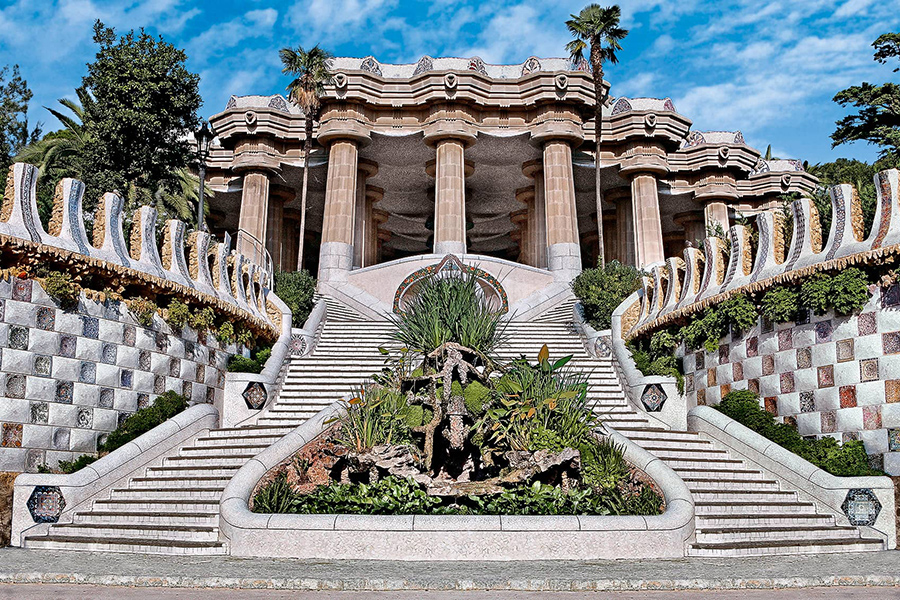
Q. When did Park Guell become a municipal garden?
A. Park Guell opened to the public as a municipal garden in 1926.
Q. When was Park Guell declared a UNESCO World Heritage Site?
A. UNESCO declared Park Guell as a Heritage Site in 1984, as part of ‘Works of Gaudi’, a series of seven attractions created by Gaudi.
Park Guell Tickets
Tickets to Park Güell with Audio Guide
Instant Confirmation
Mobile Ticket
Flexible Duration
Audio Guide
Guided Tour
More details +
Park Güell Guided Tour with Skip-the-Line Access
Free Cancellation
Instant Confirmation
Mobile Ticket
Flexible Duration
Guided Tour
More details +
Combo (Save 5%): Park Güell + Sagrada Familia Skip-the-Line Tickets
Instant Confirmation
Mobile Ticket
Flexible Duration
Guided Tour
More details +
€44.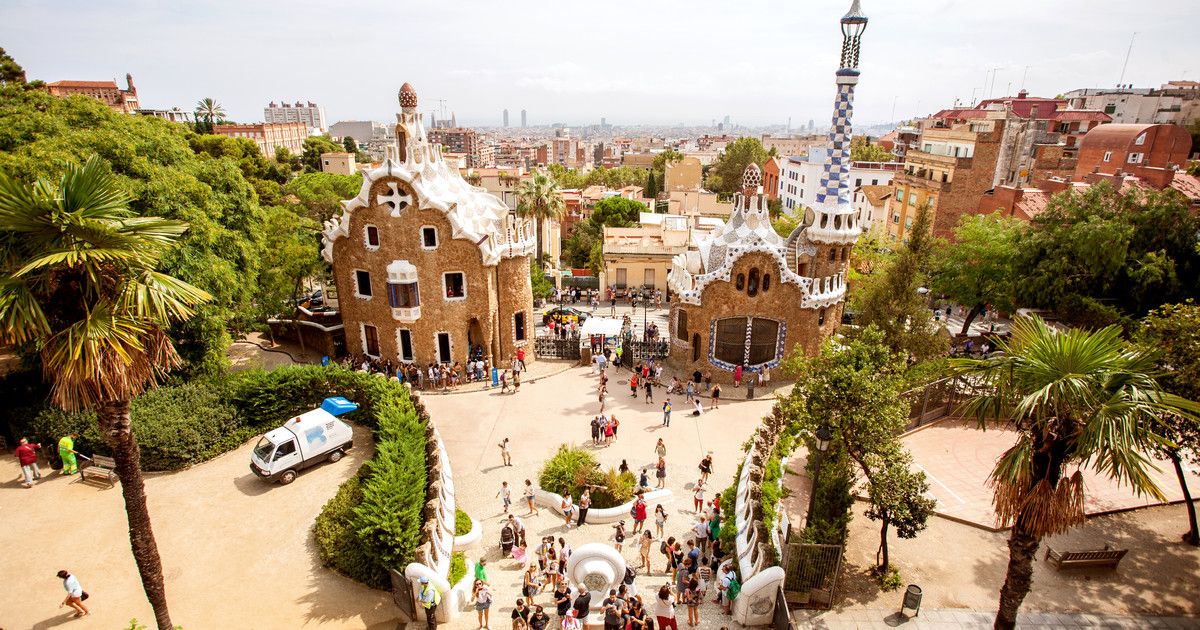
Best of Barcelona: Guided Tour of Park Güell and Sagrada Familia
Free Cancellation
Instant Confirmation
Mobile Ticket
3 hr. 30 min. – 4 hr. 30 min.
Guided Tour
More details +
Combo (Save 10%): Park Guell + Casa Mila Skip-the-Line Tickets
Instant Confirmation
Mobile Ticket
Flexible Duration
Audio Guide
More details +
€34.20
Combo (Save 10%): Park Güell + Casa Batlló Skip-the-Line Tickets
Instant Confirmation
Mobile Ticket
Flexible Duration
Audio Guide
More details +
€43.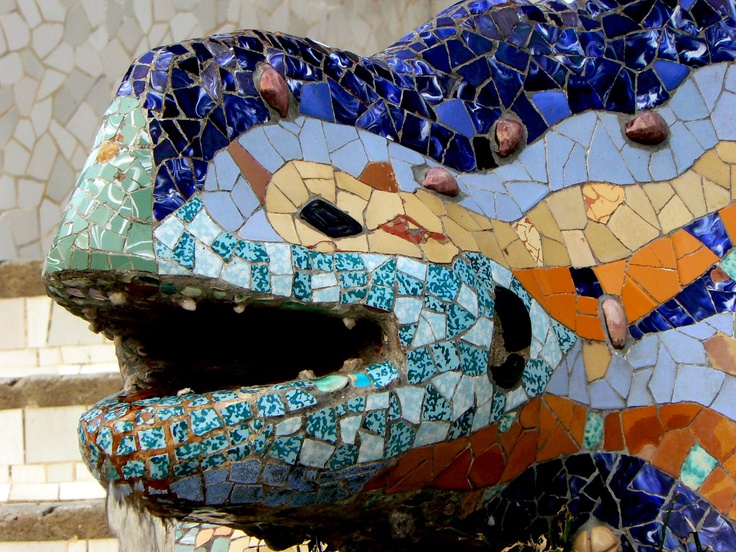
Best of Gaudí: Park Güell & Sagrada Familia Guided Tour
Free Cancellation
Instant Confirmation
Mobile Ticket
4 hr. 30 min.
Guided Tour
More details +
More Reads
About Park Guell
Plan Your Visit to Park Guell
Tips For Visiting Park Guell
About Park Guell in Barcelona
Barcelona is the culturally rich, vibrant capital city of Spain’s Catalonia region. From sunny beaches to gorgeous buildings, Barcelona has a lot to offer its visitors. Park Guell, designed by Antoni Gaudi, is one such attraction. The UNESCO heritage site is a must-visit if you are in Barcelona.
A visit to the park gives us insight into the brilliance of Gaudi and is a great way to discover his eclectic and unique style. The venue is steeped in history, and today, it is one of the most famous landmarks in the city, seeing over 9 million visitors annually.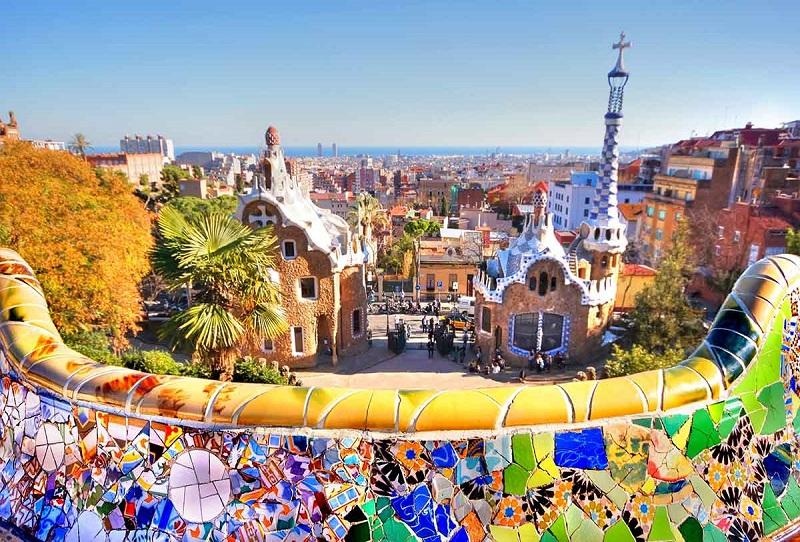
Quick Guide to Park Guell
Also Known As: Parc Güell (Catalan)
Location: Carmel Hill, Gracia, Barcelona
Established: 1914
Architect: Antoni Gaudi
Architectural Style: Modernisme
Number of Visitors Per Year: 12 million
UNESCO World Heritage Site Designation: 1984
Facts About Park Guell
What is Park Guell?
- Landmark: Located right on the edge of Barcelona Park Guell is a beautiful park full of bright colors, interesting architecture, lush greenery, and more!
- Open since 1923: The park is named after Eusebi Güell, a rich entrepreneur, who commissioned Gaudi to build a luxury residential complex. When the project was abandoned, Gaudí designed a park. Created between 1900 and 1914, Park Guell has been open to the public since 1923.
- UNESCO World Heritage Site: In 1984, it was declared as a World Heritage Site by UNESCO.
The park was made following the architectural style that made Gaudi famous: Catalan Modernism.
- Covers 19 hectares: Spread across 19 hectares, you will find rounded forms, undulating lines, and structures covered in rainbow-colored mosaic and iron gates come together to create a space that is magical in every sense of the word.
Why is Park Guell famous?
Park Guell is one of the largest green spaces in Barcelona. The park, which covers 19 hectares and houses quirky buildings as well as a nature reserve and biodiversity, is located in the Gracia district of Barcelona.
There are a number of distinct spaces and structures designed by Antoni Gaudi that can be found inside the park. The colorful mosaic Dragon that will greet you as soon as you enter the park, Sala Hipòstila (the Hypostyle Room), Museu del Guarda (Guard Museum), Jardins d’Àustria (Gardens of Austria), Plaça de la Natura (Nature Square or terrace), Pòrtic de la Bugadera (Wash House Portico) and interesting roads, viaducts, and paths and the large terraces that offer wonderful views over the city are all creations born straight out of Gaudi’s genius.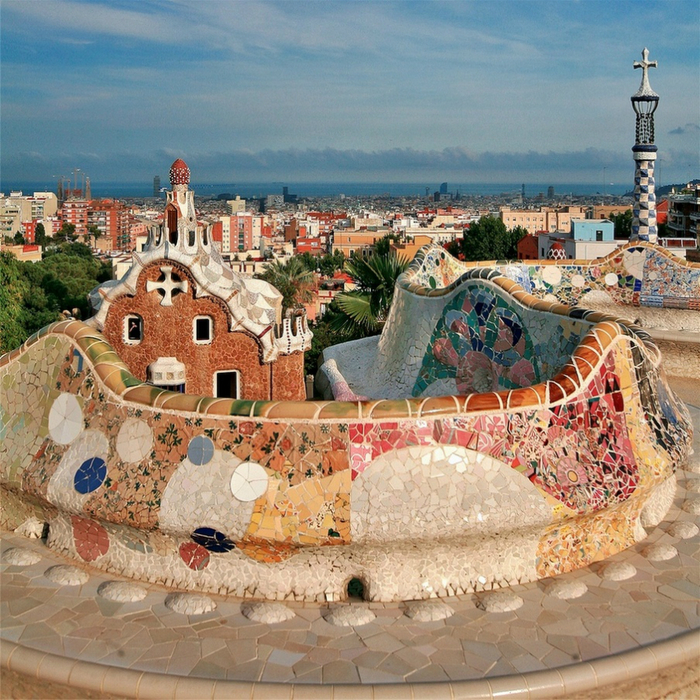
Plan Your Visit To Park Guell
Where is Park Guell Located?
Address: 08024, Barcelona, Spain
Find On Map
Park Guell is located between the neighborhoods of El Coll, La Salut, Vallcarca i els Penitents, El Carmel and Can Baró, in the districts of Gràcia and Horta-Guinardó. It is spread across the two hills of Les Menes and El Carmel.
The surrounding areas are urban neighborhoods that are highly populated. The green park, therefore, offers a respite from the concrete jungle, easing urban pressure and improving the area’s environmental quality.
Know More
Park Guell Opening Hours
Park Guell is open daily. The opening hours are:
From 1 July to 31 August 2022: 9 AM to 7:30 PM
From 1 September to 29 October 2022: 9:30 AM to 7:30 PM
30 October 2022 to 31 December 2022: 9:30 AM to 5:30 PM
Opening Hours for Residents
Citizens are free to come to the Park Güell, at no cost, at any time between 7 AM to 10 PM.
Know More
Book Park Guell Tickets & Tours
Tickets to Park Güell with Audio Guide
Instant Confirmation
Mobile Ticket
Flexible Duration
Audio Guide
Guided Tour
More details +
Park Güell Guided Tour with Skip-the-Line Access
Free Cancellation
Instant Confirmation
Mobile Ticket
Flexible Duration
Guided Tour
More details +
Combo (Save 5%): Park Güell + Sagrada Familia Skip-the-Line Tickets
Instant Confirmation
Mobile Ticket
Flexible Duration
Guided Tour
More details +
€44.
Best of Barcelona: Guided Tour of Park Güell and Sagrada Familia
Free Cancellation
Instant Confirmation
Mobile Ticket
3 hr. 30 min. – 4 hr. 30 min.
Guided Tour
More details +
Combo (Save 10%): Park Guell + Casa Mila Skip-the-Line Tickets
Instant Confirmation
Mobile Ticket
Flexible Duration
Audio Guide
More details +
€34.20
Combo (Save 10%): Park Güell + Casa Batlló Skip-the-Line Tickets
Instant Confirmation
Mobile Ticket
Flexible Duration
Audio Guide
More details +
€43.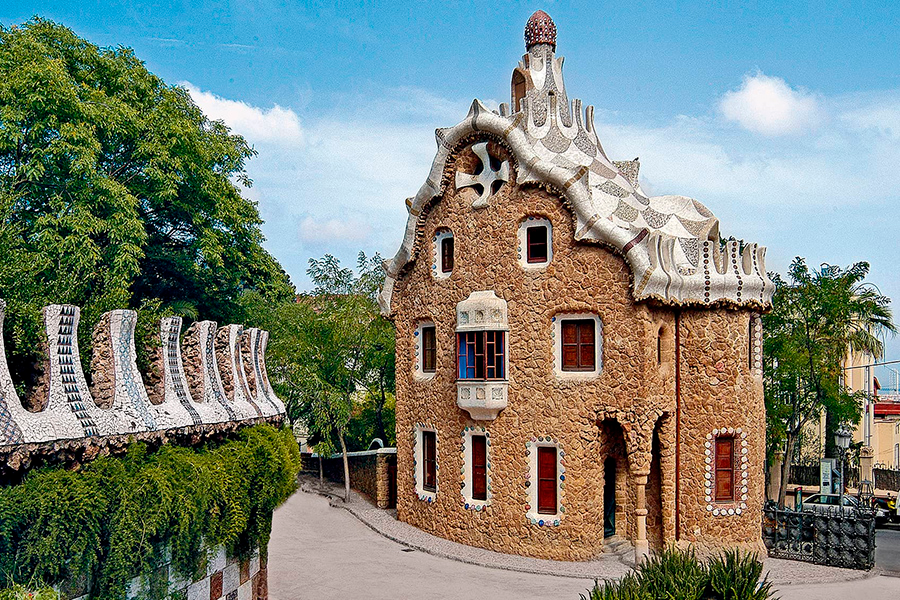
Best of Gaudí: Park Güell & Sagrada Familia Guided Tour
Free Cancellation
Instant Confirmation
Mobile Ticket
4 hr. 30 min.
Guided Tour
More details +
Park Guell Entrances
Park Guell has three entrances:
- Main Entrance: This is located right next to the Porter’s Lodge Pavilion.
- Carretera del Carmel: This is located on the west of the park.
- Av. del Santuari de St. Josep de la Muntanya: This is on the eastern side and can be accessed via mechanical stairs.
How to Choose the Right Entrance to Park Guell?
Zones of Park Guell
The park is divided into two zones:
Monumental Zone
The monumental zone spread over 12 hectares is the core attraction of the landmark.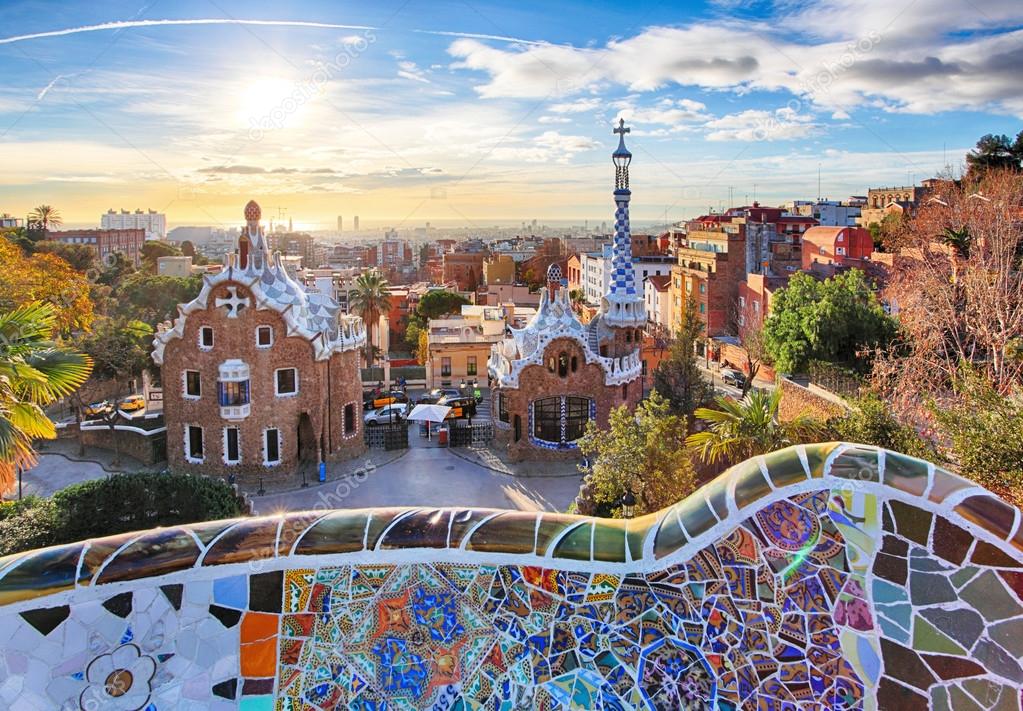
Know More
Forest Zone
The adjacent woodland zone is spread over another 8 hectares. The woodland zone is open for everyone to visit and doesn’t require a ticket.
Things to See at Park Guell Barcelona
Park Guell is a magic wonderland created by Antoni Gaudi. Here are some of the things to look out for inside Park Guell.
Pathways And Viaducts
Gaudi designed Park Güell with the idea of merging it with the natural surroundings and hilly topography. To achieve this, he laid down an intricate network of paths, bridges, and viaducts throughout the property. The three viaducts that glide up the mountain in succession are called Pont de Baix, the Pont del Mig, and the Pont de Dalt. These examples of ingenious structural engineering are supported by columns and vaults made of sketchy stones that were found on site.
Porter’s Lodge Pavilion
The main entrance to Park Güell has an impressive facade and presents a stunning view of the work of art inside.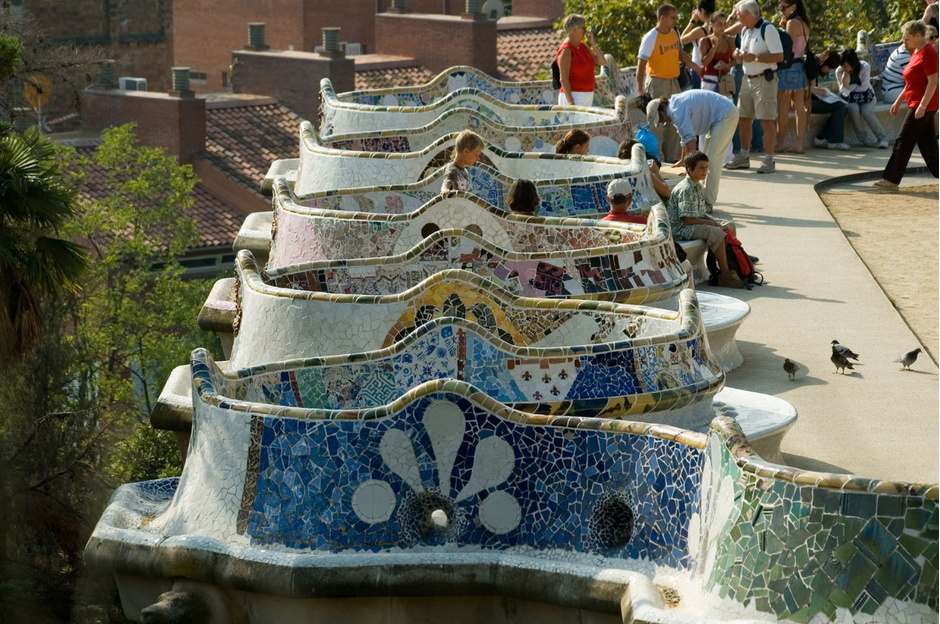
Three Cross Hill
The Three Cross Hill is the highest viewpoint in Park Guell and offers beautiful views of the city of Barcelona. Getting to the top will require some effort, as there is steep stairway to climb, but the breathtaking views at the top of the hill make the journey well worth the effort.
Gaudi House Museum
One of the original homes in the park, Gaudi House Museum is now a collection of the fabled architect’s life and work. To enter the museum, you’ll need to buy a separate ticket from the Park Guell website since the regular tour does not cover the museum.
The Dragon Stairway
An artistic twin flight of steps rises up from the entrance to the Hypostyle Room. Divided into three sections, the stairway has a fountain running along its edge and each landing on the way up is marked by a distinct element.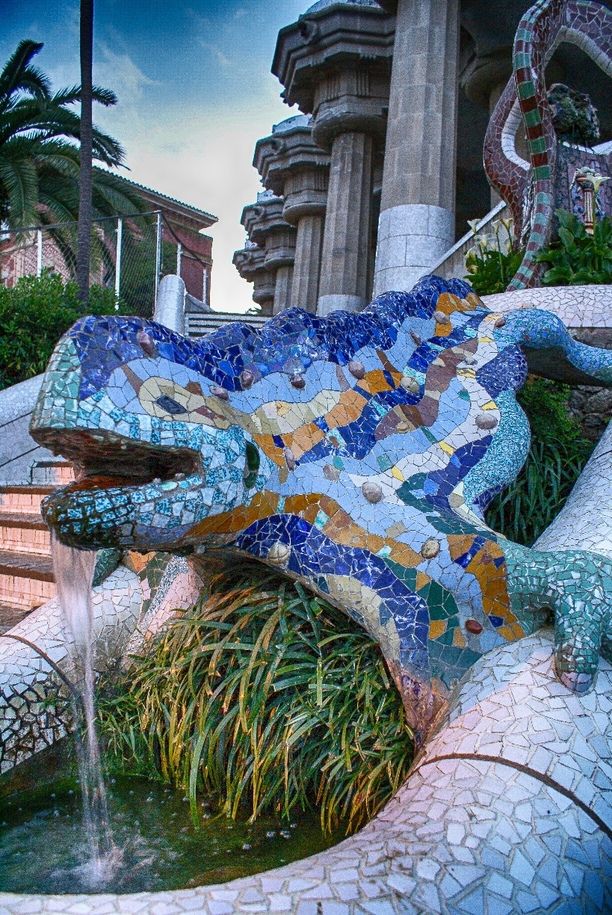
The Hypostyle Room
The Dragon Stairway culminates into an enormous space called the Hypostyle room. The entire space is supported by 86 striped columns, with the outermost ones sloping in an undulating form contrary to the rules of classical composition. This area was intended to be the marketplace for the estate.
Greek Theatre
At the heart of Park Güell lies the huge open air space originally called the Greek Theatre and now called Plaça de la Natura (Nature Square). This vast platform was planned to stage large open-air shows.
Austria Gardens
With trees donated from Austria, this part of the park has a very distinguished look. The Austria gardens have a beautiful view and host two prominent houses, one of which was acquired by Gaudi’s family which has now been converted into Gaudí House museum.
Who Designed Park Guell?
Antoni Gaudi I cornet, one of the most significant visual artists of the 19th and 20th centuries from Spain, developed Park Guell.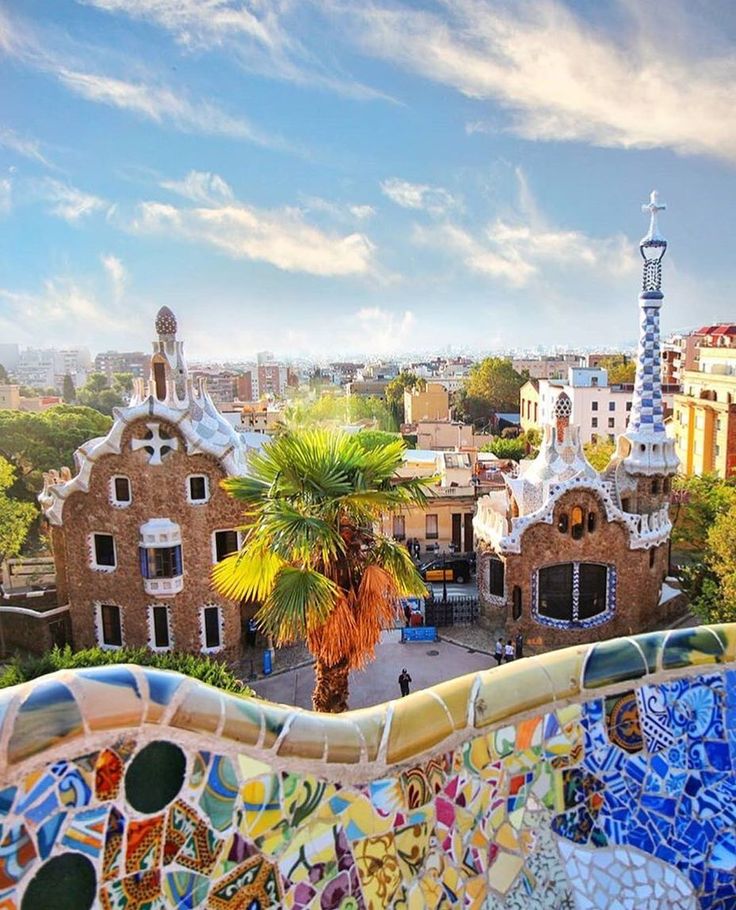
Renowned for his intricate craftwork in buildings all across Spain, Gaudí’s works have a highly individualized, sui generis style. Most of these buildings are located in Barcelona, including his glorious masterpiece, the church of the Sagrada Família.
During his studies, Gaudí constructed several projects, among which the following stand out: a cemetery gate (1875), a Spanish pavilion for the Philadelphia World Fair of 1876, a quay-side building (1876), and a university assembly hall (1877).
Design & Architecture of Park Guell
The natural beauty of Park Güell is planned in a way to provide the serenity and quiet that a park may offer. The green space is interspersed with creations by Gaudi that blend seamlessly with the nature that surrounds it.
You will find evidence of Gaudi’s signature Modernisme style throughout the park. Visitors will also get to see the use of Trencadís throughout the park.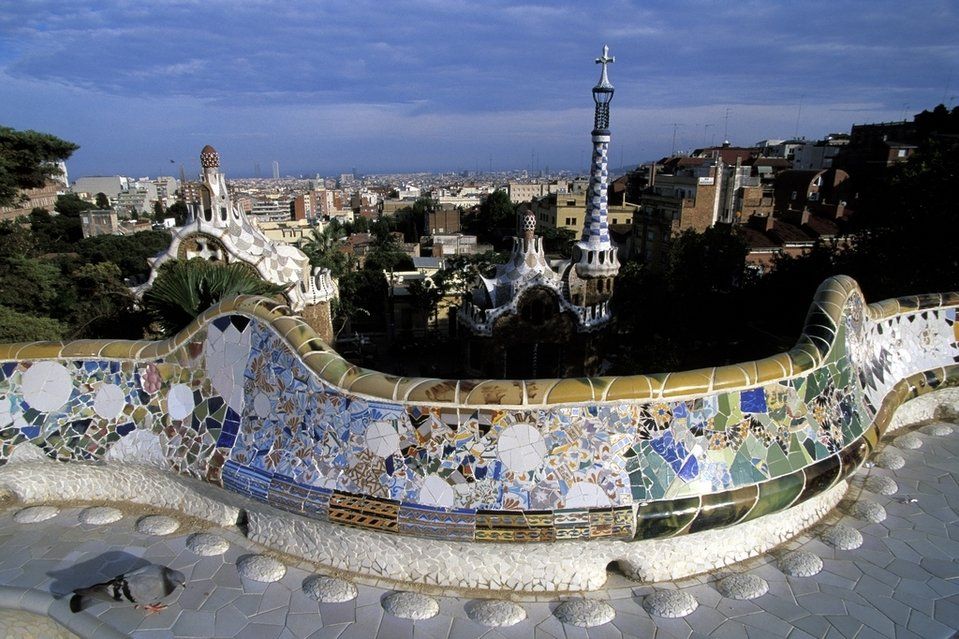
Guests will find various animals throughout the park, designed in Trencadís mosaic. The most famous of these creations is the El Drac, located at the entrance to the park. Park Guell also includes motifs from Catalan nationalism, religious mysticism, and ancient poetry. From its highest point, the park features a stone hill with numerous steps leading to a platform where three large crosses are mounted. The official name of this is “El Turó de les Tres Creus,” however it is popularly called Calvary. From here, you can enjoy panoramic views of Barcelona.
History of Park Guell In A Nutshell
Park Guell was originally supposed to be a housing complex for the aristocratic families of Barcelona. Count Eusebi Güell, after whom the park has been named, commissioned the legendary architect Antoni Gaudí to design it. Inspired by the English garden city movement, the plan was to take advantage of the fresh air and beautiful views.
However, due to various reasons, the project didn’t work out, and the estate was converted into a private garden. In 1926, Park Guell open to the public. In 1963, the house that Gaudi used to live in was converted into the Gaudi House Museum (Casa Museu Gaudí). In 1969 it was declared a historical-artistic monument of national interest. In 1984, UNESCO declared the park a World Heritage Site under “Works of Antoni Gaudí”.
Know More >
UNESCO World Heritage Site
In 1984, UNESCO declared Park Guell as a World Heritage Site as part of “The Works of Antoni Gaudi”, which features seven buildings by the architect Antoni Gaudí located in Barcelona and its surrounding areas.
The other six creations of Gaudi included in the World Heritage List includes the Palau Güell, the Casa Milà-La Pedrera, the Casa Vicens, the Nativity Façade and the Crypt of the Sagrada Família, the Casa Batlló, and the Crypt of the Colònia Güell.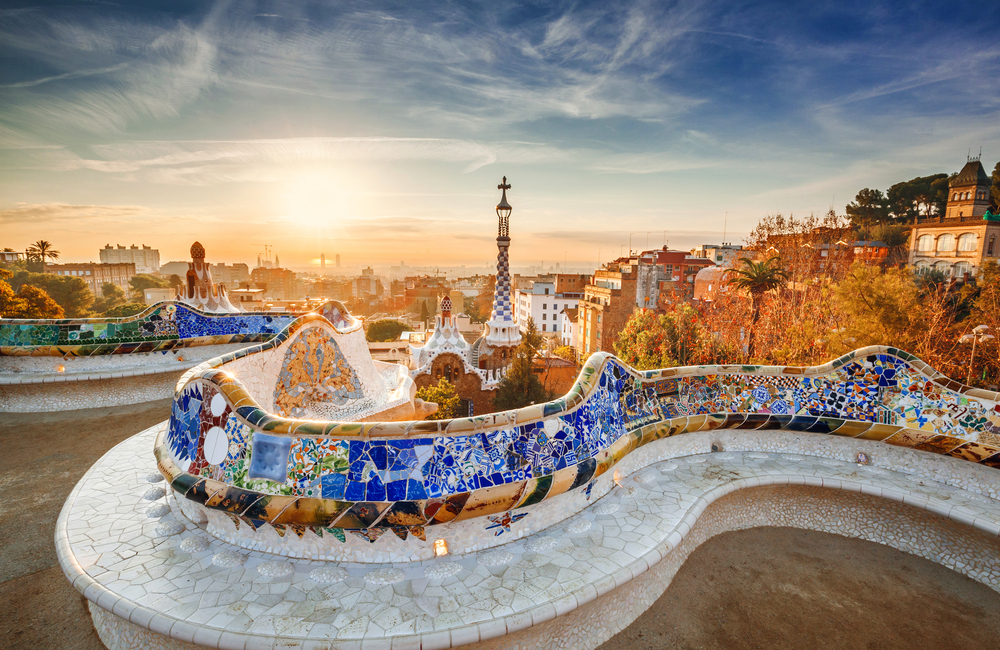
Know More
Nature & Biodiversity at Park Guell
Park Guell has been designed in a way to protect and promote the nature and biodiversity of the area.
Due to its proximity to Collserola hills and other green areas, this park attracts a wide range of fauna. Reptiles such as the Moorish gecko, mammals like Pipistrelle, Brown rat and birds such as the Rock dove, Nightingale, European crested tit live here.
You will also find a wide variety of flora species such as olive trees, strawberry trees, Common hawthorn, mastic trees, and red valerian trees. You can walk along the Biodiversity Route to enjoy the rich biodiversity of Park Guell.
Know More >
Frequently Asked Questions About Park Guell in Barcelona
What is Park Guell?
Park Guell is an urban park in Barcelona, Spain that was designed by Antoni Gaudi.
Why is Park Guell Barcelona famous?
Park Guell is Barcelona’s landmark park. It is the second most-visited park in Barcelona after Parc de la Ciutadella, and resonates with Modernist elements like no other place.
Is it safe to visit Park Guell Barcelona?
Yes, it is perfectly safe to visit Park Guell Barcelona, as a number of health measures are in place to ensure safety of visitors.
How much are Park Guell Barcelona tickets?
Park Guell tickets start at €10 for adults, while guided tours start at €27.
What can I do at Barcelona Park Guell?
Park Guell Barcelona has a number of highlights such as The Dragon Stairway, The Serpentine Bench, Austria Gardens, El Drac, and Laundry Room Portico, among others.
Who designed Park Guell?
Park Guell was designed by legendary architect Antoni Gaudi, who is also the mastermind behind Casa Batllo, Casa Mila, and Casa Vicens.
When was Park Guell built?
Park Guell was planned and designed by Antoni Gaudi (1852-1926), between 1900 and 1914. His original designs were altered due to financial reasons, and the park opened in 1926, ten years after his death.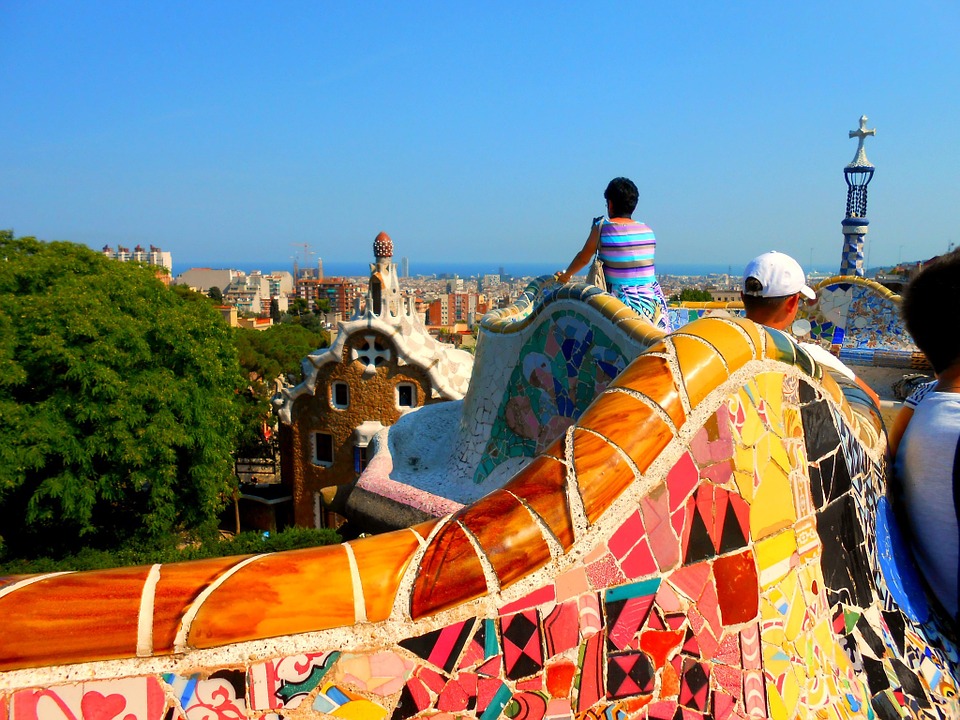
Where is Park Guell located?
Park Guell is located between the neighborhoods of El Coll, La Vallcarca, El Carmel and La Floresta in Barcelona.
How can I get to Park Guell?
What are Park Guell Barcelona timings?
Park Guell is currently open from 9 AM to 7:30 PM.
How many entrances does Park Guell Barcelona have?
Park Guell has three entrances — the main entrance, Carretera del Carmel, and Av. del Santuari de St. Josep de la Muntanya.
Why is there a restricted zone in Park Guell?
From October 2013, Barcelona City Council began regulating entry to the main core of the park with the objective of preserving the iconic space and keeping it in the best possible state of conservation. For a number of year prior, unregulated entry had begun to take its toll on the surroundings, the flora of the park and contributed to degradation of Gaudi’s sculpture. In order to avoid worsening of the situation, visitor tickets are being regulated.
More Reads
Plan Your Visit to Park Guell
Tips For Visiting Park Guell
Map of Park Guell
Park Güell in Barcelona – an amazing creation of Gaudí
I’m here:
home
›
Virtual School
›
Geography
›
In the luxurious Park Güell
Geography
I invite you for a walk with the highlight of the Spanish city of Barcelona – the unsurpassed and strikingly beautiful Park Güell.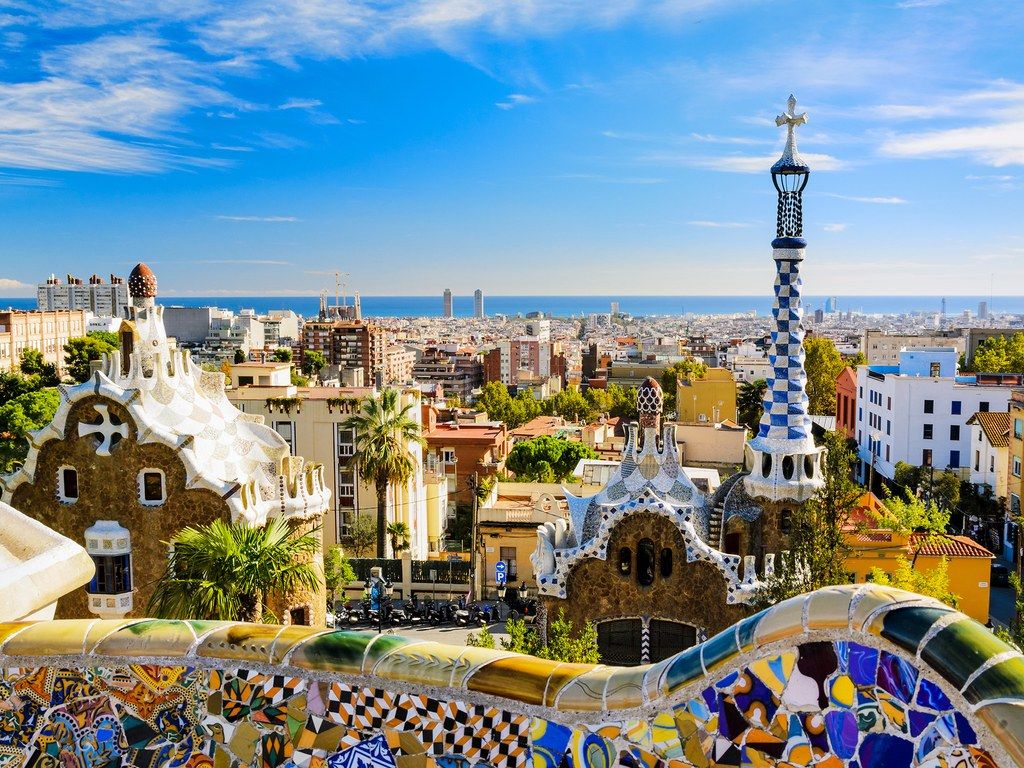
415 t.0
Every year this unique place is visited by 4 million tourists . It is not surprising, because the park is so captivating with a variety of colors and quirkiness of forms that one involuntarily wants to stay here forever.
Parc Güell – the work of the famous architect Gaudí . Now the park is on the UNESCO World Heritage List. But its history began in 1900.
A wealthy Catalan Eusebi Güell purchased a large plot of land on the outskirts of Barcelona and commissioned Antonio Gaudí to build a real architectural masterpiece there — garden city . The tycoon hoped to sell the land plots of the new complex and make good money. However, the garden was so far from the center of Barcelona that there were only a few who wanted to live here. Therefore, after the death of Güell , the Barcelona City Hall bought the land and opened the city park here, which is currently very popular among visitors.
Two cute gingerbread houses will meet you at the entrance to the park . Take a closer look at ventilation pipes , it is interesting that they are made in the form of red fly agarics.
Moving on. Behind the “sweet” houses begins the majestic staircase leading to the Hundred Columns Hall . Although in reality there are not 100, but 86.
salamander (the eternal symbol of fire), decorated with colored mosaics, looks at visitors from the steps with a sly look.
The Hall of a Hundred Columns has excellent acoustics , so concerts are often held here for park visitors.
“Why build so many columns in one place?” You ask. The ingenious Gaudí not only decorated the hall with them, but also hid the water supply system inside , can you imagine? When it rains, water flows through pipes inside the columns into a special cistern.
There are no straight lines or corners in the interior of the complex .
The impression is that the park was built without preliminary measurements, “by hand”. The ceiling and walls are decorated with bright mosaics and various patterns.
The Greek theater flaunts over the “Hall of a Hundred Columns” . Whether performances were staged here, no one knows for sure, but it is known that mass meetings were held on this site, for example, to raise charitable funds.
There are the famous wavy bench, where you can relax and admire the picturesque scenery. Sitting on the bench is very comfortable, because Gaudi gave it anatomical forms .
Park Güell abounds with bizarre columns of amazing shapes and sizes.
The roads in the garden city are arranged in special structures, reminiscent of surf waves .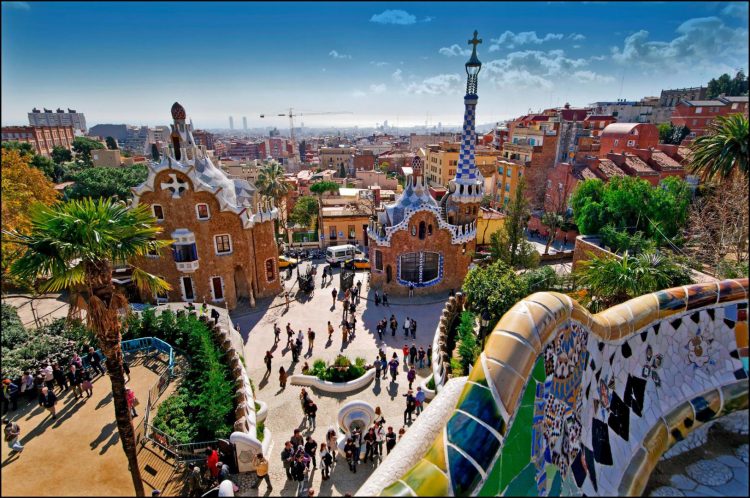
Park Güell is an incredibly beautiful, interesting and unusual place. Therefore, walking along the green streets of this luxurious garden, do not forget to take your camera with you to capture the brightest moments of your trip to Barcelona.
Tags: AmazingTravel
Noticed a spelling mistake? Select it with the mouse and press Ctrl+Enter
Related materials
Festival of Lights
The most famous winter paintings
UN birthday
Top Free Attractions…
Feast of heaven
Japan Light Festival
When animals become people…
Mexican Carnival
90,000 Guel Park: History of the Creation, Description, Photo
Address: Spain, Barcelona
Created: in 1900 – 1914
Architect: Antoni Gaudi
Main attributes: Particular, Building, building, building park, Gaudí house-museum, mosaic Salamander, bench, hall and ceiling of a hundred columns, walking alley
Coordinates: 41°24’50.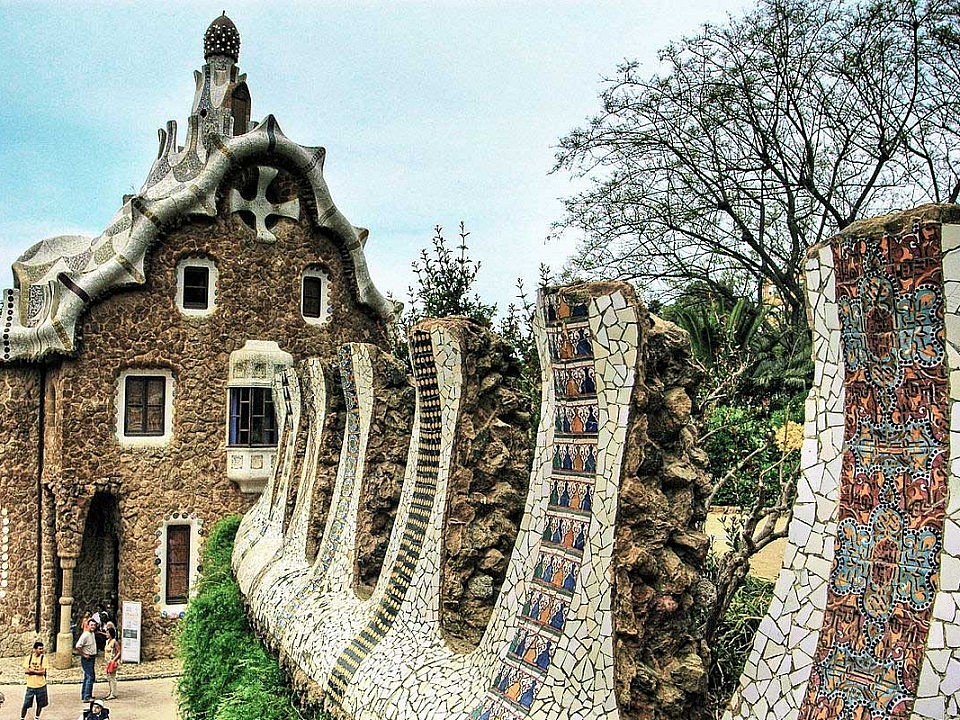
Content:
Short description
History of creation
Park Güell – today
Park Güell on the map
Short description
One of the most majestic and luxurious parks on our planet, which can compete even with the great imperial gardens from China, is located in Barcelona and is called Park Güell.
View of the front staircase from the porter’s house
This amazing place, with an area of just over 17 hectares, constantly attracts the attention of not only tourists who have visited the capital of Catalonia, but also the natives of Barcelona. Where else, if not in Parc Güell, you can take a break from the bustle of the metropolis and enjoy the singing of thousands of birds hiding in the dense groves of pine trees and palm alleys? Park Güell, where you can always meet admirers of the great Antonio Gaudi’s talent and couples in love, is located in the northwestern part of the beautiful city.
It could not be otherwise, because the greatest architect, the genius of the twentieth century, the legendary Antonio Gaudi, worked on the arrangement of the park, with its bizarre alleys, fabulous-looking buildings, water sources and sculptures. Parc Güell is one of Gaudí’s most famous masterpieces and was inscribed on the well-known UNESCO World Heritage List in 1984. However, in the same year, UNESCO took under its protection all the creations of Gaudi, without exception, because the world of beauty, which the architect created, should certainly remain for posterity.
From left to right: the gatekeeper’s house, the administration building
The world-famous organization was pushed to take such a step by the situation connected with the Park Güell and his estate.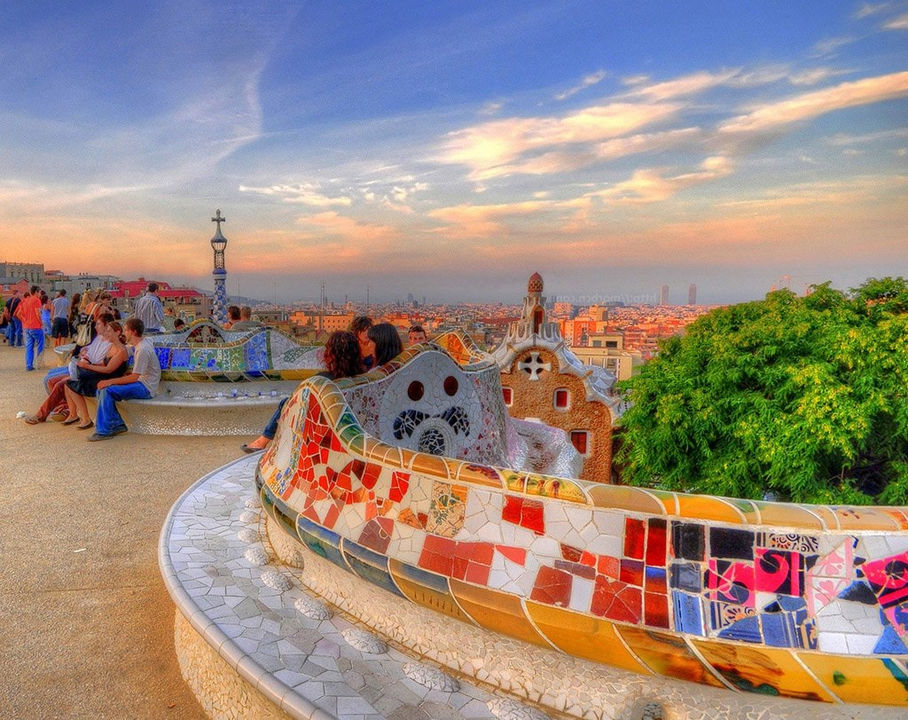
Park Güell – history of creation
there is a park on it. At the beginning of the twentieth century, Eusebi Güell returned from Foggy Albion and wanted to build a garden city near his beloved Barcelona, where every inhabitant could feel unity with nature and forget about noise and problems for a while, instill in their children a sense of beauty and love for their surroundings. environment.
Mosaic salamander on the front staircase
In addition, Güell believed that the acquisition of land is also a profitable investment of money.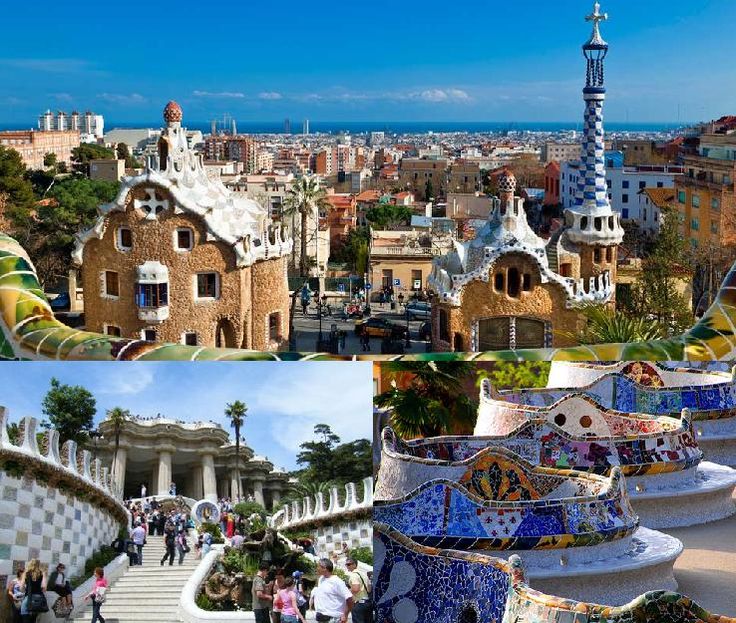
Initially, it was planned to build up to forty houses and luxurious villas for wealthy residents of Catalonia in a secluded garden city. Naturally, not everyone could afford to buy a plot and start building there. Of the estimated number of buildings, only three were erected. One of them was erected by the architect Julie Balvel for the wealthy and famous lawyer of that time M. Trias i Domenech, and the architect Francesc Berenguer worked on the creation of the second house.
A snake-headed medallion located on the main staircase just below the mosaic Salamander
This building was immediately put up for sale, but it did not attract a single buyer until 1906.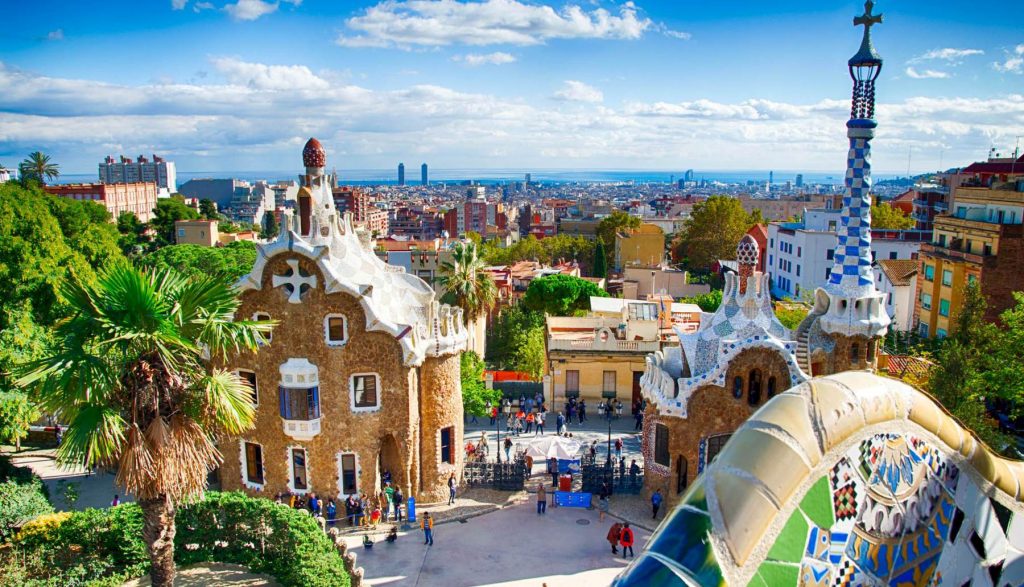
In 1901, a wealthy Catalan decides to set up a luxurious park in a deserted area. “Perhaps shady alleys, small artificial waterfalls and fountains will draw the attention of the Catalans to a vast territory?” Eusebi Güell thought something like this, attracting the still young but extremely talented Antonio Gaudi to work on the park.
Hall of a Hundred Columns
The architect from the very beginning creates a fantastic, one might even say fabulous, striking the imagination of any person, the central entrance to the park.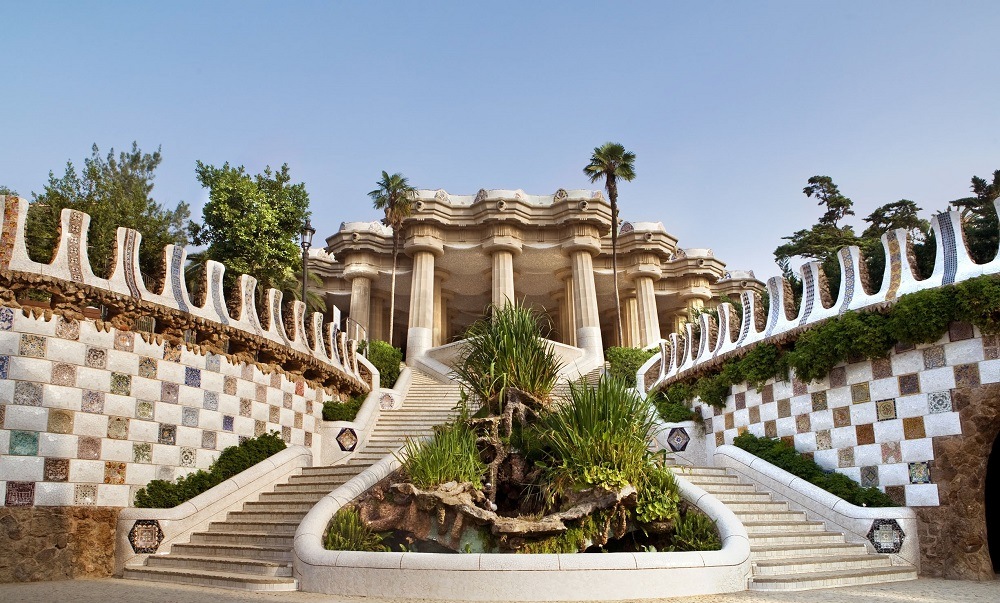
The second element of the Park Güell, which its guests can enjoy, is the magnificent grand staircase leading directly to the hall called the “Hall of a Hundred Columns”. At the bottom of the main staircase of Park Güell, Gaudí placed a sculpture of the fabulous Salamander, which is covered with an amazing color mosaic.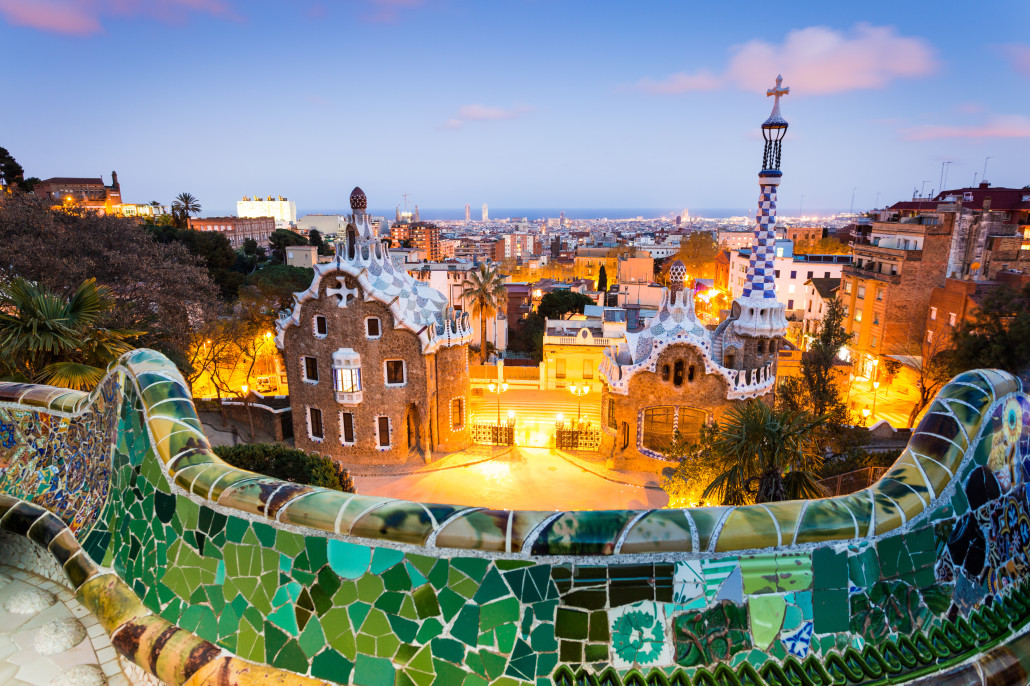
View of the park square above the hall of a hundred columns
The “Hall of a Hundred Columns” without exaggeration can be called the central composition of Parc Güell . Gaudí designed the Doric columns characteristic of the architecture of Ancient Greece. They are arranged in a cellular order, each of them is slightly inclined and expands towards the bottom. All columns are not only a decoration, but also serve as a support for the majestic ceiling. It is worth noting that the “ceiling” of the hall of a hundred columns, according to the plan of Antonio Gaudi, was supposed to perform a certain function: it was supposed to build a garden city market square on it. Here one can see Gaudi’s own vision of the ancient Roman forums or venues where theatrical performances were given.
True, nearby hills would serve as tiers, and the houses of wealthy Catalans would serve as seats. The area of this central composition is 86×40 meters. The plan for the marketplace was never put into practice. The architect created a giant curved bench on the central platform, made in the form of a snake that lives in the depths of the sea. This bench is another proof of Gaudí’s rationalism and practicality: it is extremely comfortable to rest on it. This architect was able to achieve by studying the anatomy of the human body. Even a completely naked person sat down on a soft plaster bench and, thereby, gave Gaudi the opportunity to give it the necessary and “comfortable” shape for the vacationer.
Bench in the park square
Working on the Park Güell, Gaudí decided for the first time in his work to use the terrain to create amazing scenery. He did not compare the hills, did not remove any, even the smallest, hills.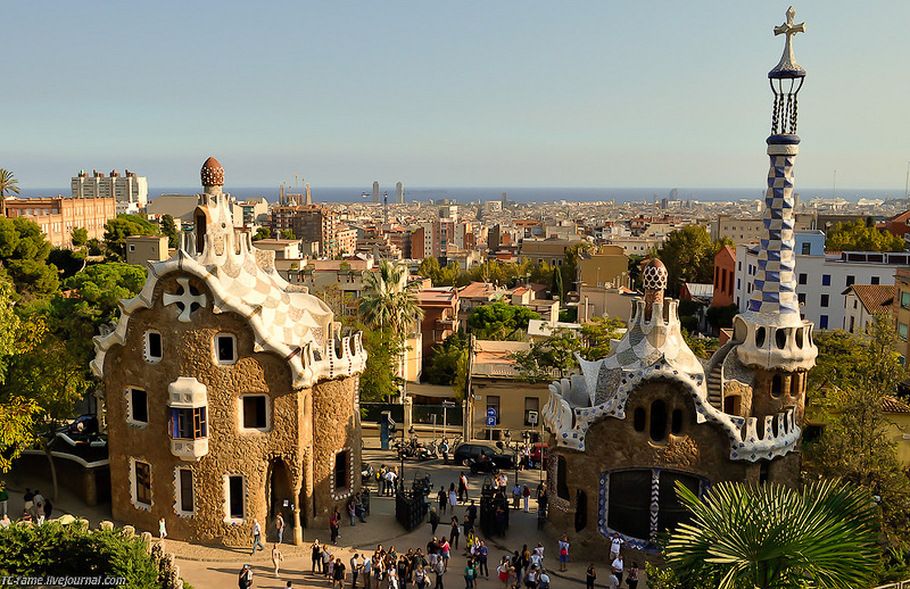
It would be unfair not to mention that Josep Maria Jujol took an active part in the construction of Parc Güell. This talented man, inspired by the genius of Gaudí, created amazing collages from construction waste, the marriage of the glassblowing and ceramic industries. We can safely say that Antonio Gaudi and Josep Maria Jujol became the founders of surrealism and abstractionism in architecture.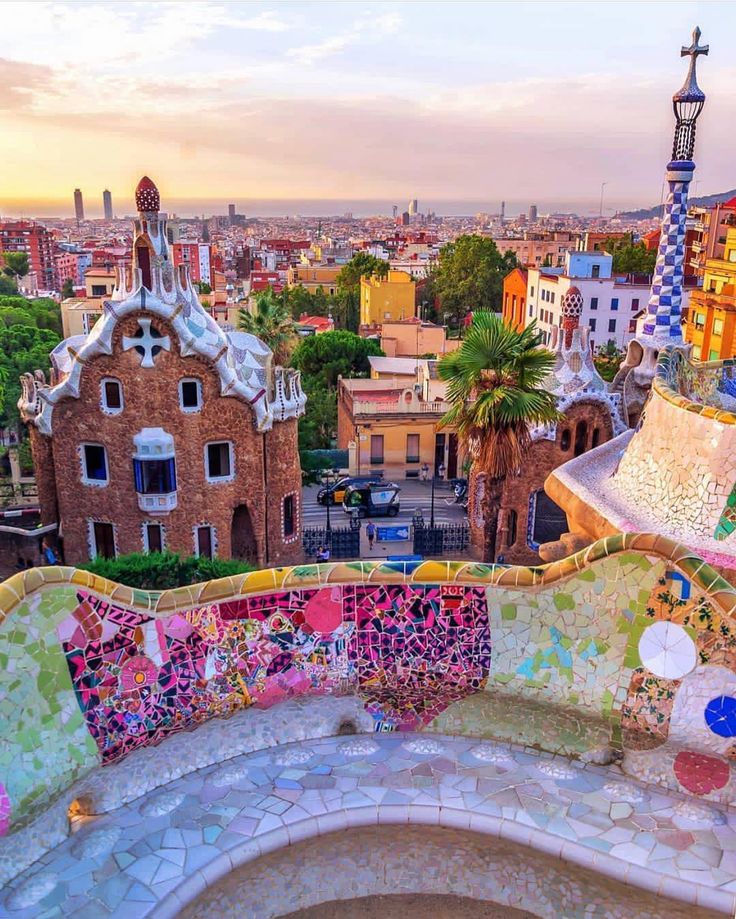
Fragment of a bench
Park Güell – today
Almost every tourist who comes to Barcelona does not miss the opportunity to take an amazing walk through the Park Güell, which can be safely compared to a trip to a fairy tale. What could be better than walking along a network of paths, smoothly turning into wide walking alleys, made by Antonio Gaudí from smooth stone quarried in the vicinity of Barcelona? These alleys are somewhat reminiscent of bird nests (!), which seem to protrude from the surrounding hills. In Park Güell, a huge number of trees and bizarre shrubs currently grow. And this despite the fact that just over 100 years ago this place looked like a desert scorched by the sun. Only the great architect managed to solve the problem of irrigating the soil with the help of aqueducts and cisterns in which rainwater is collected.
It so happened that the heirs of Eusebi Güell could not maintain the park on their own, so they decided to sell it to the authorities of Barcelona.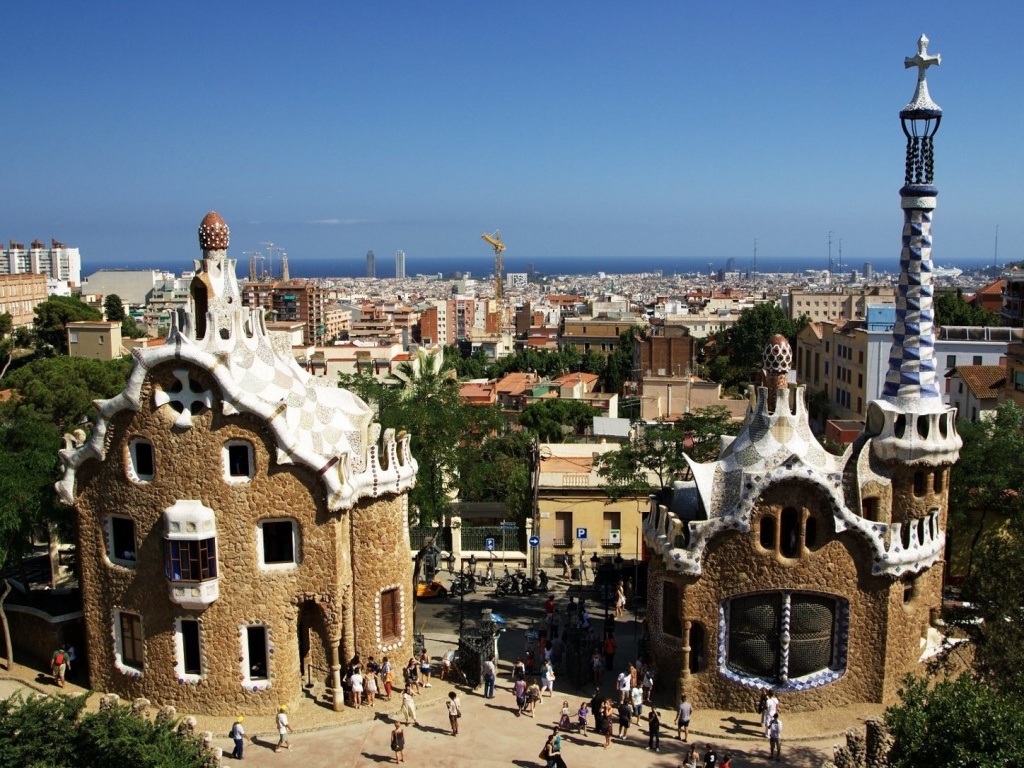
Walking alley
All houses built on the territory of Park Güell have survived to the present day , which is surprising if you look back at the attitude of the authorities of Barcelona to the masterpieces of Gaudí in the middle of the twentieth century. It is also surprising that the house of the lawyer M. Trias i Domenech and the territory adjacent to it, despite the inexorable course of time and various economic crises, still belongs to his direct heirs. The house, which was purchased by Eusebi Güell himself, today is a municipal school, and in the mansion where Antonio Gaudi lived and created his projects for quite a long time, his museum is located. In it you can see amazing exhibits that belonged to the great architect, as well as pieces of furniture and decor designed by him and taken from Casa Batlló and Casa Mila.

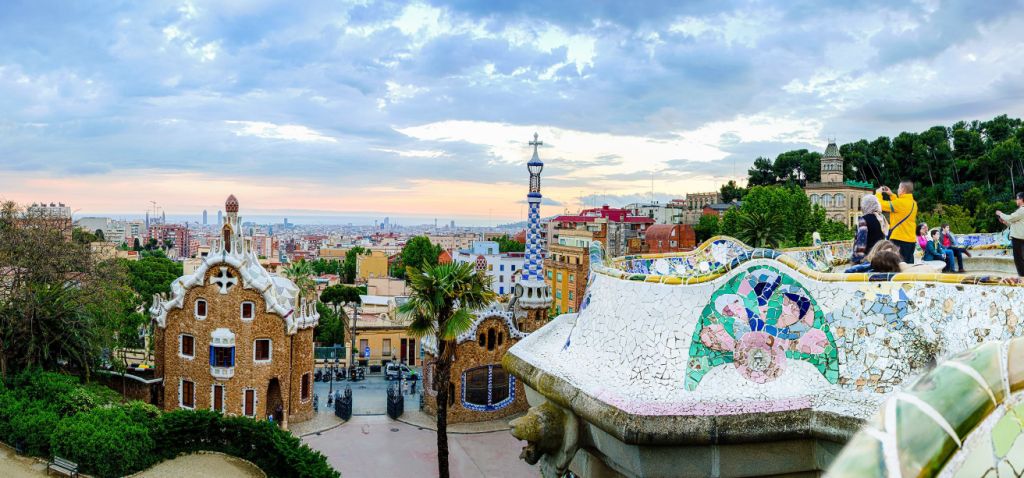 The park was made following the architectural style that made Gaudi famous: Catalan Modernism.
The park was made following the architectural style that made Gaudi famous: Catalan Modernism. 